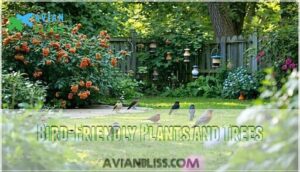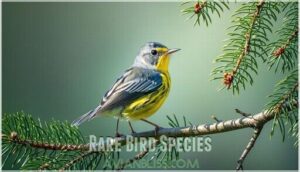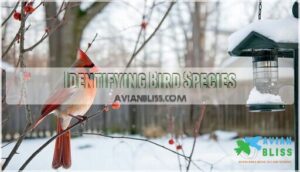This site is supported by our readers. We may earn a commission, at no cost to you, if you purchase through links.

Cardinals flash their brilliant red plumage while chickadees announce themselves with their namesake call.
Blue jays, American robins, and mourning doves are reliable visitors to feeders and birdbaths.
In wilder areas, you might encounter red-tailed hawks soaring overhead or downy woodpeckers drumming on trees.
Each region hosts its own mix – hummingbirds dominate the west while eastern bluebirds brighten eastern states.
Even city dwellers aren’t left out, with house sparrows and rock pigeons adapting to urban environments.
Understanding these feathered neighbors opens up a world of backyard biodiversity.
Table Of Contents
- Key Takeaways
- Common Backyard Birds
- Birds of North America
- Waterfowl Species
- Birds of Prey
- Songbirds of North America
- Woodpeckers and Nuthatches
- Rare Bird Species
- Identifying Bird Species
- Frequently Asked Questions (FAQs)
- What are the top 10 most common birds?
- What are the 3 largest birds in North America?
- What is the most common bird in North America?
- How many types of birds are there in North America?
- What is the most common bird in the world?
- Are there rare birds in North America?
- What are seabirds of North America?
- Where do birds live in North America?
- Which bird is only found in the USA?
- What are the top 20 bird names?
- Conclusion
Key Takeaways
- You’ll find many common birds like Northern Cardinals, Blue Jays, and American Robins in your backyard, especially around feeders and birdbaths.
- Different bird species adapt to specific regions, like hummingbirds in the west and eastern bluebirds in eastern states.
- Providing feeders, birdhouses, and native plants in your yard helps attract and support a variety of bird species year-round.
- Conservation is vital since habitat loss and climate changes threaten many birds, including rare species like Kirtland’s Warbler.
Common Backyard Birds
You’ll find your backyard can host a variety of fascinating bird species, from vibrant Northern Cardinals to curious Blue Jays.
These common visitors bring life to your outdoor space, adapting to feeders, plants, and trees that suit their needs, making it a great place for curious birds.
Invite vibrant birds to your backyard with feeders, plants, and trees, creating a lively haven for nature’s curious visitors year-round.
Birds That Visit Feeders
Bird feeders attract common backyard birds like chickadees, sparrows, and finches.
Feeder preferences vary—suet feeders draw woodpeckers, while nyjer feeders lure goldfinches. Seed types matter; sunflower seeds are a favorite.
Proper feeder placement guarantees safety from predators. Use squirrel deterrents to protect food.
Winter feeding supports North American birds when natural resources dwindle, making bird feeding tips essential.
Attracting Birds to Your Yard
To bring common backyard birds closer, create a welcoming space.
Add bird baths for hydration and nesting boxes for shelter.
Plant native plants to provide food and cover, and reduce pesticides to protect their diet.
Winter feeding guarantees year-round activity, with vibrant, lively visitors, and these bird feeding tips attract birds but also enhance your bird watching experience.
Types of Bird Feeders
Once you’ve got birds visiting, choosing the right feeder matters.
Tube feeders suit small seed preferences, while platform feeders attract diverse feeder birds.
Use sturdy feeder materials like metal or plastic to withstand weather.
Place feeders strategically for bird safety and squirrel deterrents.
Follow a bird feeder guide, clean regularly, and enjoy bird watching tips as you observe feeding habits up close.
Many enthusiasts find specific tube feeders especially effective.
Bird-Friendly Plants and Trees
After setting up feeders, think about native plantings to enhance bird habitats.
Berry bushes like elderberry or serviceberry provide seed sources and attract North American birds. Nesting trees, such as oak or pine, offer shelter plants for safety.
These choices complement bird feeding habits and create inviting spaces for attracting birds year-round. Consider sourcing bird-friendly plants to further improve the bird habitat.
A balanced yard truly becomes a bird feeder guide in action.
Birds of North America
North America is home to an incredible variety of bird species, each adapted to unique habitats and behaviors.
From migratory patterns to feeding habits, understanding these birds offers a glimpse into the continent’s rich ecological diversity.
Migratory Patterns
Migration is a survival masterpiece for North American birds, driven by migration triggers like daylight changes.
Bird species rely on navigation methods such as Earth’s magnetic field. Stopover ecology highlights rest areas critical for fueling up.
Climate impacts, like warming, alter bird migration patterns, creating conservation challenges. Protecting these routes guarantees the safety of birds and their incredible journeys.
Many birds depend on celestial navigation skills during their long flights.
Habitat and Distribution
Bird species distribution in North America varies widely due to geographic variation and habitat types.
Common birds adapt to urban habitats, forests, and wetlands, while others face challenges like habitat loss and climate change.
Range expansion occurs as adaptable species thrive in human-altered environments.
From robins in lawns to hawks in open country, diverse habitats shape where birds live and flourish in human-altered environments.
Diet and Foraging Habits
Understanding bird foraging strategies reveals how species adapt to diverse habitats.
Many birds adjust their diets seasonally, ensuring survival. Urban adaptations often show fascinating behaviors, like scavenging or feeder visits.
Here’s what drives their feeding habits:
- Dietary needs: Seeds, insects, fruits, or nectar.
- Prey selection: Hawks hunt rodents; owls prefer nocturnal prey.
- Seasonal diets: Robins switch to berries in winter.
- Bird behavior: Jays cache food for later.
Conservation Status
While learning about diet and foraging, it’s eye-opening to see how habitat loss and climate impact threaten common birds.
Over one-third of North America’s bird species face population declines, with conservation efforts vital to reversing this trend.
Bird conservation status reports highlight species like Kirtland’s warbler, emphasizing the need to combat population decline and protect essential habitats for threatened species.
Waterfowl Species
You’ll find waterfowl species like ducks, geese, swans, and pochards in wetlands, lakes, and rivers across North America.
These birds are well-adapted for aquatic life, with features like webbed feet and waterproof feathers.
Ducks and Geese
Among North America’s waterfowl species, ducks and geese stand out for their varied habitats and behaviors.
Mallards thrive in wetlands, easily recognized by their vivid markings. Canada geese, with lifelong bonds, often graze near water.
Understanding waterfowl migration patterns and duck diets enhances appreciation for these types of birds.
Geese have longer necks compared to ducks.
Goose conservation efforts guarantee their survival in this rich bird species list, ensuring the long-term survival of these birds.
Swans and Pochards
Swans are graceful giants of North America’s waterways, often spotted gliding serenely. Pochards, by contrast, are diving ducks with bold plumage.
Here’s what to know:
- Swan Identification: Look for long necks and pure white feathers.
- Pochard Habitats: Prefer lakes and marshes.
- Breeding Behaviors: Swans mate for life.
- Conservation Concerns: Hybridization risks threaten genetic diversity.
Birds of Prey
When you think of birds of prey, you’re picturing nature’s top aerial hunters, like hawks, eagles, owls, and falcons.
These raptors use sharp talons, powerful beaks, and keen eyesight to hunt, making them fascinating and essential predators in ecosystems across North America.
Hawks and Eagles
Spotting hawks and eagles, North America’s iconic raptors, requires sharp bird identification skills.
The Red-tailed Hawk, with its rusty tail, soars over open habitats, while eagles, symbols of strength, dominate skies.
These predators face habitat loss and conservation challenges.
Their hunting techniques, from swooping dives to sharp talon grips, showcase nature’s precision.
| Species | Key Feature | Habitat |
|---|---|---|
| Red-tailed Hawk | Rusty tail feathers | Open country |
| Bald Eagle | White head, dark body | Near water |
| Golden Eagle | Golden nape | Mountains, plains |
Owls and Falcons
Owls and falcons, iconic birds of prey, showcase incredible adaptations.
Nocturnal hunters like the Great Horned Owl rely on silent flight and sharp talons, while falcons, such as the American Kestrel, dive with unmatched speed.
Owl pellets reveal dietary secrets, connecting us to nature’s food web.
These raptors inspire awe, and efforts in raptor conservation and falconry history preserve their legacy.
Diet and Hunting Habits
From stealthy owls to soaring hawks, birds of prey showcase fascinating foraging strategies and hunting techniques.
Red-tailed hawks perch patiently, scanning for rodents, while kestrels hover mid-air, targeting insects.
Seasonal diets often shift—goshawks hunt mammals in winter, birds in summer.
These dietary adaptations highlight their survival skills, offering a compelling bird behavior analysis for anyone curious about bird feeding and prey selection.
Songbirds of North America
Songbirds fill North America with their vibrant colors and intricate melodies, making them a favorite among bird enthusiasts.
From sparrows and finches to warblers and thrushes, these small yet diverse species play essential roles in ecosystems while enchanting your backyard with their melodies.
Sparrows and Finches
Moving from the skies to your yard, Sparrows and Finches bring song and color.
Sparrows, like Chipping and Tree Sparrows, have distinct songs and prefer seeds. Finches, including House Finches and American Goldfinches, adapt well to feeders and habitats.
- Sparrow Identification: Look for streaked backs and unique calls.
- Finch Habitats: Enjoy open areas and suburban yards.
- Seed Preferences: Millet and sunflower hearts attract both.
Warblers and Thrushes
You’ve admired sparrows and finches, but warblers and thrushes bring a unique charm to North America.
Warbler identification can be tricky—like the Yellow-rumped Warbler’s color variations—while thrushes, such as Swainson’s Thrush, captivate with their melodic vocalizations.
Each species has distinct habitat preferences, and understanding these differences enriches bird species identification.
Conservation challenges highlight their need for protected spaces.
Migration Patterns
Bird migration is guided by triggers like day length and temperature changes.
Birds navigate with magnetic fields and stars, using stopover sites to rest and refuel.
Climate impacts are shifting routes, studied in bird migration research.
Conservation challenges grow as habitats vanish, but bird migration studies reveal solutions.
Understanding bird migration patterns can protect species and maintain these awe-inspiring journeys.
Woodpeckers and Nuthatches
You’ll often spot woodpeckers drumming away on tree trunks, using their chisel-like beaks to uncover insects hidden beneath the bark.
Nuthatches, with their compact bodies and unique habit of climbing down trees headfirst, are equally fascinating as they scavenge for seeds and insects, showcasing their unique abilities.
Common Woodpecker Species
A variety of woodpeckers call North America home, each thriving in unique habitats.
Here are five common species:
- Downy Woodpecker: Found in forests and backyards nationwide.
- Hairy Woodpecker: Similar to the Downy but larger.
- Red-bellied Woodpecker: Vibrant, frequent in eastern woodlands.
- Pileated Woodpecker: Famous for loud drumming.
- Northern Flicker: Ground-feeding, often seen in open areas.
Characteristics of Woodpeckers
Woodpeckers are fascinating with sturdy beaks designed for drumming behavior and chiseling into wood.
Unique anatomy, like their shock-absorbing skulls and long tongue adaptations, helps them hunt insects.
Species like the Downy, Hairy, and Red-bellied Woodpecker nest in tree cavities.
They’re essential to ecosystems, aiding woodpecker conservation efforts, and their diets vary widely, from insects to berries.
Rare Bird Species
Rare bird species are a reminder of nature’s fragility, relying on specific habitats and protections to survive.
Understanding their challenges helps you appreciate the importance of conservation efforts and habitat preservation.
Endangered Birds
Endangered birds face challenges like habitat loss, climate change, and invasive species, leading to population declines.
Species such as the California Condor and Kirtland’s Warbler highlight the urgent need for bird conservation efforts.
Conservation organizations focus on habitat restoration and bird species protection, ensuring rare birds like the Whooping Crane can thrive.
Over 1,400 species are threatened with extinction, making active conservation efforts essential for their survival.
Threatened Birds
While endangered birds face imminent extinction, threatened species stand just one step away on conservation status lists, struggling against habitat loss and climate change impacts.
You’ll find these birds battling multiple conservation challenges:
- Kirtland’s warbler’s haunting song echoing through fewer jack pine forests each year
- Northern spotted owl’s silent flight threatened by invasive species
- Yellow-billed cuckoo’s distinctive call fading from riverside habitats
- Piping plover’s lonely tracks along disappearing shorelines
- Red knot’s incredible migration journey shortened by population decline
Conservation Efforts
While threatened birds face numerous challenges, conservation initiatives across North America are making remarkable progress.
Organizations like NABCI and Partners in Flight coordinate efforts to combat habitat loss and climate change impacts.
You’ll find success stories everywhere—25 bird species have been rescued from critical endangerment since 2000.
Through citizen science programs, you can join the 40% reduction in bird extinction rates.
North American bird conservation relies on everyone’s participation in monitoring, research, and habitat restoration.
Habitat Preservation
While conservation efforts focus on species protection, the homes where birds live need just as much attention.
Habitat preservation battles the growing threat of habitat loss caused by urban sprawl and climate change.
Creating safe spaces for birds can happen in many ways:
- Participating in reforestation efforts in your community
- Supporting land trust organizations that protect natural areas
- Advocating for bird-friendly building designs
- Transforming your yard into a mini bird sanctuary
The most effective bird conservation strategies protect not just the birds, but where they live.
Identifying Bird Species
You’ll learn to recognize birds by observing their distinctive features, including color patterns, size, shape, behavior, and songs.
Whether you’re watching cardinals at your feeder or spotting warblers in the forest, identifying common North American birds becomes easier with practice and the right techniques.
Bird Identification Tips
The key to successful bird identification lies in observing a combination of features rather than focusing on just one.
Start with size and shape, then note plumage variations, habitat specifics, and behavioral clues.
Listen carefully to vocalizations—bird sounds and calls often reveal species faster than visual cues.
Keep a bird field guide handy and watch for seasonal changes in appearance.
Bird markings, especially on wings and face, provide essential identification details.
A good idea is to purchase a reliable guide book to help identify birds.
Common Bird Identification Mistakes
Now that you’ve learned some identification tips, let’s look at where many bird watchers trip up. Even experienced birders make these common mistakes:
- Confusing Similar Species like American crows and ravens based solely on size
- Misidentifying birds in Juvenile Plumage as separate species
- Overlooking Seasonal Changes in appearance and behavior
- Ignoring Auditory Cues that often reveal more than visual markings
Regional Variations can also complicate identification, making a reliable bird guide essential for accurate observations.
Habitat and foraging habits are key indicators that are often overlooked, leading to misidentification, so be sure to take into account behavior and habitat when identifying birds, considering complete concepts and common mistakes to improve your skills.
Advanced Bird Identification Techniques
Birders who master advanced identification techniques can spot differences that novices often miss.
Careful observation transforms challenging IDs into confident conclusions.
| Technique | Application | When to Use | Tools Needed | Difficulty Level |
|---|---|---|---|---|
| Plumage Variations | Note subtle color patterns | Year-round | Good binoculars | Moderate |
| Vocalizations Analysis | Distinguish similar bird sounds | Dawn/dusk | Recording app | Advanced |
| Seasonal Changes | Track molting patterns | Migration periods | Bird identification guide | Intermediate |
| Behavioral Cues | Observe flight patterns | Any time | Patience | Beginner |
| Hybrid Identification | Compare to parent species | Breeding season | Reference photos | Expert |
The techniques include Plumage Variations, Vocalizations Analysis, Seasonal Changes, Behavioral Cues, and Hybrid Identification, each with its own application and required tools, allowing birders to improve their skills and become more proficient in bird identification.
Frequently Asked Questions (FAQs)
What are the top 10 most common birds?
You’ll find American Robins, Mourning Doves, Northern Cardinals, Blue Jays, American Crows, House Sparrows, Red-winged Blackbirds, Dark-eyed Juncos, European Starlings, and American Goldfinches among North America’s top 10 most common birds.
They are thriving across diverse habitats.
What are the 3 largest birds in North America?
In terms of size, the California Condor soars above the rest, followed by the Whooping Crane with its striking white plumage.
The regal Bald Eagle, a powerful symbol of strength across North America.
What is the most common bird in North America?
The most common bird in North America is the Dark-eyed Junco, with a remarkable population of over 630 million.
You’ll often spot these sociable little birds flocking to feeders, especially during the winter months.
How many types of birds are there in North America?
You’d be amazed to know there are over 1,100 bird species in North America.
From colorful warblers to majestic hawks, this continent is a treasure trove of feathered friends, thriving in diverse landscapes and habitats.
What is the most common bird in the world?
The most common bird in the world is the domestic chicken, with a population exceeding 25 billion.
Found globally, chickens thrive in almost every environment, providing food and companionship to billions of people.
Are there rare birds in North America?
Yes, North America is home to rare birds like the Kirtland’s Warbler, which nests only in young jack pine forests.
The Whooping Crane, a majestic but endangered species with limited populations.
What are seabirds of North America?
Seabirds in North America include puffins, albatrosses, gulls, terns, shearwaters, and cormorants.
They live along coasts and open oceans, relying on fish and marine life.
Many migrate vast distances, perfectly adapted to coastal and pelagic environments.
Where do birds live in North America?
Birds in North America thrive across forests, wetlands, grasslands, mountains, and even cities.
You’ll spot adaptable species in backyards and urban parks, while others prefer specific habitats like dense woods or coastlines to survive and nest.
Which bird is only found in the USA?
Think of the Kirtland’s warbler as the ultimate homebody—it nests only in young jack pine forests, mostly in Michigan.
This rare bird’s strict habitat needs make it a true U.S.
-exclusive treasure.
What are the top 20 bird names?
Here are 20 iconic bird names: Northern Cardinal, Blue Jay, American Robin, Mourning Dove, Red-winged Blackbird.
Great Horned Owl, American Crow, Bald Eagle, Dark-eyed Junco, Snowy Owl, Mallard.
European Starling, American Goldfinch, Chickadee, Barred Owl, Northern Mockingbird, Red-tailed Hawk.
Cedar Waxwing, White-breasted Nuthatch, and Chipping Sparrow.
Conclusion
Like puzzle pieces fitting together, understanding common bird species in North America reveals the complex beauty of nature around you.
From vibrant songbirds at feeders to majestic raptors soaring above, each bird tells a story of survival, migration, and adaptation.
By noticing their habits, creating bird-friendly spaces, and protecting habitats, you’ll thoroughly explore the biodiversity thriving in your backyard.
With a pair of binoculars and curiosity, you can uncover a world of feathered wonders waiting to be explored.














